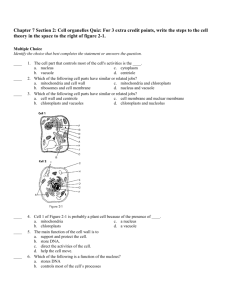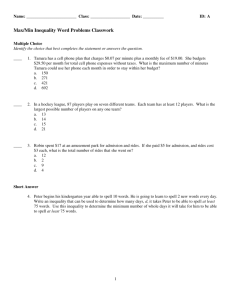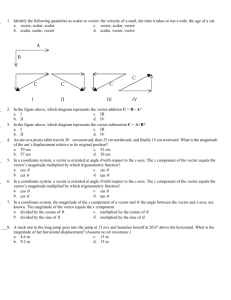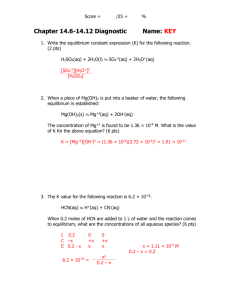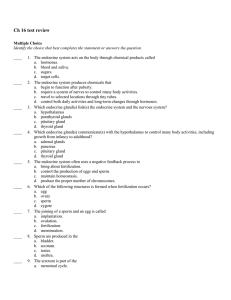Physics Chapter 2 Test: Forces, Equilibrium, Vectors
advertisement
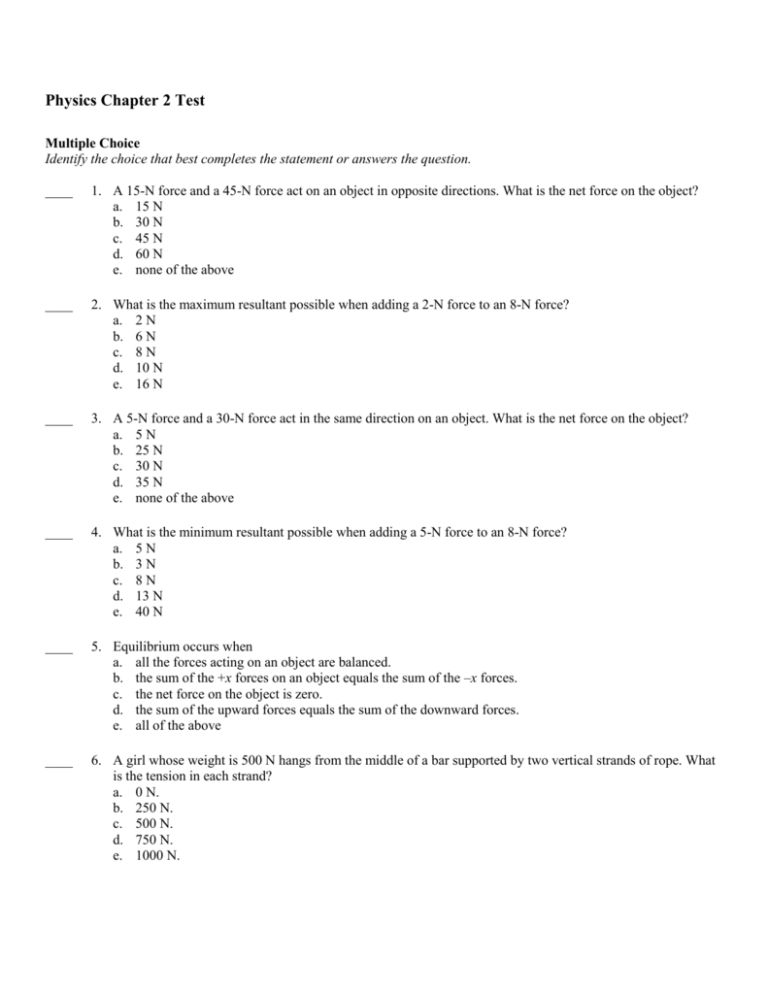
Physics Chapter 2 Test Multiple Choice Identify the choice that best completes the statement or answers the question. ____ 1. A 15-N force and a 45-N force act on an object in opposite directions. What is the net force on the object? a. 15 N b. 30 N c. 45 N d. 60 N e. none of the above ____ 2. What is the maximum resultant possible when adding a 2-N force to an 8-N force? a. 2 N b. 6 N c. 8 N d. 10 N e. 16 N ____ 3. A 5-N force and a 30-N force act in the same direction on an object. What is the net force on the object? a. 5 N b. 25 N c. 30 N d. 35 N e. none of the above ____ 4. What is the minimum resultant possible when adding a 5-N force to an 8-N force? a. 5 N b. 3 N c. 8 N d. 13 N e. 40 N ____ 5. Equilibrium occurs when a. all the forces acting on an object are balanced. b. the sum of the +x forces on an object equals the sum of the –x forces. c. the net force on the object is zero. d. the sum of the upward forces equals the sum of the downward forces. e. all of the above ____ 6. A girl whose weight is 500 N hangs from the middle of a bar supported by two vertical strands of rope. What is the tension in each strand? a. 0 N. b. 250 N. c. 500 N. d. 750 N. e. 1000 N. ____ 7. The weight of a person can be represented by a vector that acts a. in a direction that depends on where the person is standing. b. perpendicular to the ground underneath the person. c. parallel to the ground. d. straight down, even if the person is standing on a hill. e. all of the above ____ 8. What would be the safest way to put up a clothesline? a. It doesn't make any difference which way the line is strung. b. With the line very tight c. With some slack in the line ____ 9. A barge is being pulled along a canal by two ropes that make equal angles with the direction in which the barge points. Assuming the two pulls on the barge are equal, in what direction does the barge move? a. It oscillates back and forth between the two banks. b. It moves straight ahead. c. It moves in the direction of the resultant force on it. d. both A and B e. both B and C ____ 10. A clothesline is stretched between two trees. A tire hangs in the middle of the line and the two halves of the line make equal angles with the horizontal. The tension in the line is a. half the tire’s weight. b. is less than half the tire’s weight. c. is more than half the tire’s weight. ____ 11. What is needed to describe a vector quantity? a. only magnitude b. only direction c. both magnitude and direction d. neither magnitude nor direction ____ 12. A scalar quantity has a. only direction. b. only magnitude. c. both magnitude and direction. d. neither magnitude nor direction. ____ 13. In order to find the components of a vector, you should a. draw the vector with correct magnitude and orientation. b. measure the sides of the rectangle. c. draw a rectangle so that the vector is the diagonal. d. all of the above ____ 14. You are helping your aunt move a piano on wheels from one room to another. When you push the piano horizontally, it moves at constant speed. What can you say about the piano? a. It is in static equilibrium. b. It is in dynamic equilibrium. c. It is in equilibrium because it doesn’t experience a friction force. d. It is in equilibrium because it experiences net force opposite to the friction force. ____ 15. A 230 kg bear grasping a vertical tree slides down at constant velocity. What is the friction force between the tree and the bear? a. Less than 230 kg. c. 230 kg. b. More than 230 kg. d. Can not be determined. ____ 16. In the diagram below, which rope has more tension, or are they the same? a. Rope A c. Same b. Rope d. Can not be determined. ____ 17. Marci, who weighs 375 N, stands on a scaffold which weighs 420 N. If the tension in the right rope is 450N, what is the tension in the left rope? a. 1245 N c. 450 N b. 405 N d. 345 N True/False Indicate whether the statement is true or false. On your answer sheet, mark A for true and B for false. ____ 18. A quantity that has both magnitude and direction is called a scalar quantity. ____ 19. A quantity that has only magnitude is called a vector quantity. ____ 20. Mass is a vector quantity. ____ 21. Objects moving at constant speed in a straight-line path are said to be in static equilibrium. ____ 22. An object in static equilibrium is in a state of no motion. Physics Chapter 2 Test Answer Section MULTIPLE CHOICE 1. ANS: STA: BLM: 2. ANS: STA: BLM: 3. ANS: STA: BLM: 4. ANS: STA: BLM: 5. ANS: STA: BLM: 6. ANS: STA: BLM: 7. ANS: STA: BLM: 8. ANS: STA: 9. ANS: STA: 10. ANS: STA: 11. ANS: STA: 12. ANS: STA: 13. ANS: STA: 14. ANS: STA: 15. ANS: KEY: 16. ANS: 17. ANS: 18. ANS: TRUE/FALSE B PTS: 1 DIF: L2 OBJ: Ph.1.g | Ph.1.i KEY: force | opposite application D PTS: 1 DIF: L2 OBJ: Ph.1.g | Ph.1.i KEY: force | resultant application D PTS: 1 DIF: L2 OBJ: Ph.1.g | Ph.1.i KEY: net force | direction application A PTS: 1 DIF: L2 OBJ: Ph.1.g | Ph.1.i KEY: force | resultant application E PTS: 1 DIF: L2 OBJ: Ph.1.e | Ph.1.m KEY: equilibrium | force comprehension B PTS: 1 DIF: L2 OBJ: Ph.1.e | Ph.1.m KEY: weight | tension application D PTS: 1 DIF: L2 OBJ: Ph.1.e | Ph.1.m KEY: weight | vector comprehension C PTS: 1 DIF: L2 OBJ: Ph.1.j KEY: tension | clothesline BLM: E PTS: 1 DIF: L2 OBJ: Ph.1.j KEY: resultant | force BLM: C PTS: 1 DIF: L2 OBJ: Ph.1.j KEY: tension | clothesline BLM: C PTS: 1 DIF: L2 OBJ: Ph.1.j KEY: tension | rope BLM: C PTS: 1 DIF: L1 OBJ: Ph.1.j KEY: vector | magnitude BLM: B PTS: 1 DIF: L1 OBJ: Ph.1.j KEY: scalar | magnitude BLM: D PTS: 1 DIF: L2 OBJ: Ph.1.j KEY: vector | magnitude BLM: B PTS: 1 DIF: L2 OBJ: equilibrium | dynamic equilibrium | static equilibrium BLM: C PTS: 1 A PTS: 1 D PTS: 1 2.1 Force 2.1 Force 2.1 Force 2.1 Force 2.2 Mechanical Equilibrium 2.2 Mechanical Equilibrium 2.2 Mechanical Equilibrium 2.3 Support Force analysis 2.3 Support Force application 2.3 Support Force application 2.3 Support Force application 2.5 Vectors knowledge 2.5 Vectors knowledge 2.5 Vectors comprehension 2.4 Equilibrium for Moving Objects application 19. ANS: STA: 20. ANS: STA: 21. ANS: STA: 22. ANS: KEY: 23. ANS: KEY: F PTS: 1 DIF: L1 Ph.1.j KEY: scalar | magnitude F PTS: 1 DIF: L1 Ph.1.j KEY: vector | magnitude F PTS: 1 DIF: L2 Ph.1.j KEY: mass | vector F PTS: 1 DIF: L2 static equilibrium | dynamic equilibrium | equilibrium T PTS: 1 DIF: L1 static equilibrium | equilibrium BLM: knowledge OBJ: BLM: OBJ: BLM: OBJ: BLM: OBJ: BLM: OBJ: 2.5 Vectors knowledge 2.5 Vectors knowledge 2.5 Vectors comprehension 2.4 Equilibrium for Moving Objects knowledge 2.4 Equilibrium for Moving Objects



